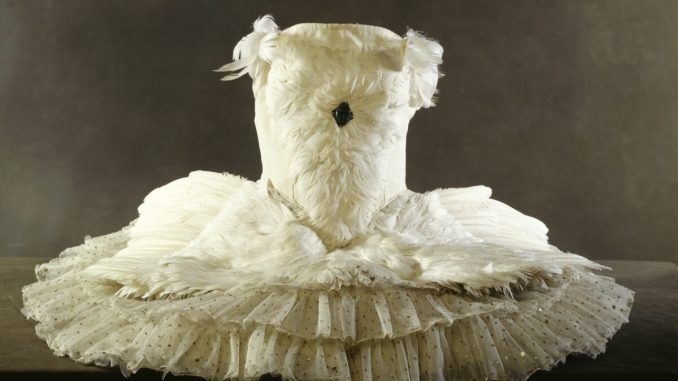
While under lockdown, staff at the Museum of London decided to edit a series of videos documenting the restoration of a rarely displayed item in the museum’s fashion and textile archive: legendary ballerina Anna Pavlova’s swan costume. Pavlova was believed to have worn the costume around 1910 for a performance of “The Dying Swan.”
The stunning costume consists of a cream-colored silk, boned bodice adorned with green glass gems and goose feathers, and a cotton tutu made from a mass of tulle and sequins that together imitate a majestic swan and its incredible plumage. When performing, Pavlova would have worn a diamanté headdress of green glass gems trimmed with feathers.

Pavlova’s swan costume would have been one of many. According to a dancer who worked with Pavlova, a fresh swan costume was made for each performance run. Pavlova performed “The Dying Swan” about 4,000 times.
The costume is rarely on display due to the garment’s delicate nature and environmentally sensitive details, including the silk material and goose feathers, the museum wrote in an email.
The footage of the restoration was shot for the museum’s “Conservation in the City” series, just before the costume was sent to New York for the exhibition “Ballerina: Fashion’s Modern Muse” at the Museum at the Fashion Institute of Technology.

The first two episodes in the five-part “Conservation in the City” series can now be viewed on the Museum of London website, and a new episode will be released each month.
In the first video, the museum’s textile conservator Emily Austin explains how she first checks the condition of the garment. At the beginning of the restoration, she estimates that the job would be completed in over 100 hours due to the complexity of the garment and its many different materials. Time and dust has dimmed the once white costume. The garment has lost its shape, and the elastic on the shoulders is gone. Austin will strengthen and realign some of the goose feathers and maybe infill them. The tulle-silk skirt is understandably worn, and over time small tears have appeared throughout the tutu, mainly on the edges, undoubtedly taking the strain of Pavlova’s expressive dying-swan song.
In the second video, Austin explains how she uses a fine rabbit-hair brush to remove the layers of dust. She then uses a museum vacuum topped with netting to remove the more stubborn surface grime. Austin then assesses the tulle damage more closely, patching up tears with hair-thin polyester thread that has been dyed to color match the material. She places a piece of netting behind each tear and then attaches the patch to the tulle by using a simple running stitch. The repair can hardly be seen, and ditto for the thread shown in the camera shot.
What is clear is the amount of patience and attention to detail that is needed for the job. We’ll have to wait for the third episode to see what happens next.
How ‘The Dying Swan’ Came to Be
“The Dying Swan” is arguably Pavlova’s most famous solo piece. Russian ballet dancer and choreographer Michael Fokine created the piece at her request in 1905. She had just been accepted as a ballerina in the Imperial Mariinsky Theatre in St. Petersburg, Russia, and was required to perform a solo piece at a gala concert given by the theater’s artists.

Fokine knew of Pavlova’s love for swans. (She would later have swans on a large pond at her London home, so she could closely imitate them in her ballet.) Fokine also knew that Pavlova enjoyed British poet Alfred Tennyson’s poem “The Dying Swan,” in which the poet wonderfully describes the swan song—the beautiful melody the swan sings as it approaches death.
I.
The plain was grassy, wild and bare,
Wide, wild, and open to the air,
Which had built up everywhere
An under-roof of doleful gray.
With an inner voice the river ran,
Adown it floated a dying swan,
And loudly did lament.
It was the middle of the day.
Ever the weary wind went on,
And took the reed-tops as it went.
II.
Some blue peaks in the distance rose,
And white against the cold-white sky,
Shone out their crowning snows.
One willow over the river wept,
And shook the wave as the wind did sigh;
Above in the wind was the swallow,
Chasing itself at its own wild will,
And far thro’ the marish green and still
The tangled water-courses slept,
Shot over with purple, and green, and yellow.
III.
The wild swan’s death-hymn took the soul
Of that waste place with joy
Hidden in sorrow: at first to the ear
The warble was low, and full and clear;
And floating about the under-sky,
Prevailing in weakness, the coronach stole
Sometimes afar, and sometimes anear;
But anon her awful jubilant voice,
With a music strange and manifold,
Flow’d forth on a carol free and bold;
As when a mighty people rejoice
With shawms, and with cymbals, and harps of gold,
And the tumult of their acclaim is roll’d
Thro’ the open gates of the city afar,
To the shepherd who watcheth the evening star.
And the creeping mosses and clambering weeds,
And the willow-branches hoar and dank,
And the wavy swell of the soughing reeds,
And the wave-worn horns of the echoing bank,
And the silvery marish-flowers that throng
The desolate creeks and pools among,
Were flooded over with eddying song.
Tennyson’s poem inspired Fokine’s dance. He choreographed the piece to “The Swan,” the 13th movement of “The Carnival of the Animals,” by French composer Camille Saint-Saëns. The movement was originally scored for a solo cello accompanied by two pianos.
Russian dance critic André Levinson described Pavlova’s performance of “The Dying Swan”:
“Arms folded, on tiptoe, she dreamily and slowly circles the stage. By even, gliding motions of the hands, returning to the background from whence she emerged, she seems to strive toward the horizon, as though a moment more and she will fly—exploring the confines of space with her soul. The tension gradually relaxes and she sinks to earth, arms waving faintly as in pain. Then faltering with irregular steps toward the edge of the stage—leg bones quiver like the strings of a harp—by one swift forward-gliding motion of the right foot to earth, she sinks on the left knee—the aerial creature struggling against earthly bonds; and there, transfixed by pain, she dies.”
Poignantly, on her deathbed in 1931, Pavlova’s last words were “Get my swan costume ready.”
To find out more about the Museum of London’s conservation of Anna Pavlova’s swan costume, visit MuseumOfLondon.org.uk






Be the first to comment